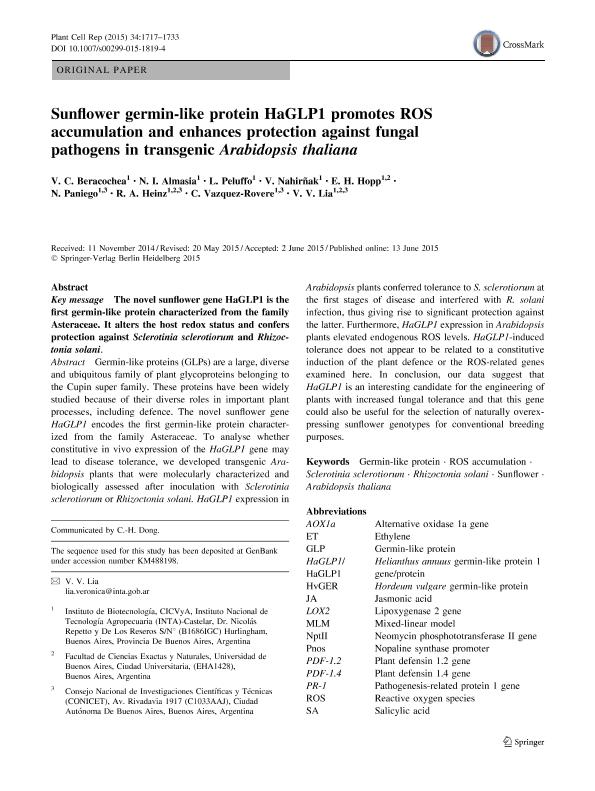Mostrar el registro sencillo del ítem
dc.contributor.author
Berecochea, Valeria C.
dc.contributor.author
Almasia, Natalia Ines

dc.contributor.author
Peluffo, Lucila

dc.contributor.author
Nahirñak, Vanesa

dc.contributor.author
Hopp, Horacio Esteban

dc.contributor.author
Paniego, Norma Beatriz

dc.contributor.author
Heinz, Ruth Amelia

dc.contributor.author
Vazquez Rovere, Cecilia

dc.contributor.author
Lia, Verónica Viviana

dc.date.available
2020-08-28T19:06:44Z
dc.date.issued
2015-06
dc.identifier.citation
Berecochea, Valeria C.; Almasia, Natalia Ines; Peluffo, Lucila; Nahirñak, Vanesa; Hopp, Horacio Esteban; et al.; Sunflower germin-like protein HaGLP1 promotes ROS accumulation and enhances protection against fungal pathogens in transgenic Arabidopsis thaliana; Springer; Plant Cell Reports; 34; 10; 6-2015; 1717-1733
dc.identifier.issn
0721-7714
dc.identifier.uri
http://hdl.handle.net/11336/112683
dc.description.abstract
Germin-like proteins (GLPs) are a large, diverse and ubiquitous family of plant glycoproteins belonging to the Cupin super family. These proteins have been widely studied because of their diverse roles in important plant processes, including defence. The novel sunflower gene HaGLP1 encodes the first germin-like protein characterized from the family Asteraceae. To analyse whether constitutive in vivo expression of the HaGLP1 gene may lead to disease tolerance, we developed transgenic Arabidopsis plants that were molecularly characterized and biologically assessed after inoculation with Sclerotinia sclerotiorum or Rhizoctonia solani. HaGLP1 expression in Arabidopsis plants conferred tolerance to S. sclerotiorum at the first stages of disease and interfered with R. solani infection, thus giving rise to significant protection against the latter. Furthermore, HaGLP1 expression in Arabidopsis plants elevated endogenous ROS levels. HaGLP1-induced tolerance does not appear to be related to a constitutive induction of the plant defence or the ROS-related genes examined here. In conclusion, our data suggest that HaGLP1 is an interesting candidate for the engineering of plants with increased fungal tolerance and that this gene could also be useful for the selection of naturally overexpressing sunflower genotypes for conventional breeding purposes.
dc.format
application/pdf
dc.language.iso
eng
dc.publisher
Springer

dc.rights
info:eu-repo/semantics/openAccess
dc.rights.uri
https://creativecommons.org/licenses/by-nc-sa/2.5/ar/
dc.subject
ARABIDOPSIS THALIANA
dc.subject
GERMIN-LIKE PROTEIN
dc.subject
RHIZOCTONIA SOLANI
dc.subject
ROS ACCUMULATION
dc.subject
SCLEROTINIA SCLEROTIORUM
dc.subject
SUNFLOWER
dc.subject.classification
Biotecnología Agrícola y Biotecnología Alimentaria

dc.subject.classification
Biotecnología Agropecuaria

dc.subject.classification
CIENCIAS AGRÍCOLAS

dc.title
Sunflower germin-like protein HaGLP1 promotes ROS accumulation and enhances protection against fungal pathogens in transgenic Arabidopsis thaliana
dc.type
info:eu-repo/semantics/article
dc.type
info:ar-repo/semantics/artículo
dc.type
info:eu-repo/semantics/publishedVersion
dc.date.updated
2020-08-28T18:40:19Z
dc.journal.volume
34
dc.journal.number
10
dc.journal.pagination
1717-1733
dc.journal.pais
Alemania

dc.journal.ciudad
Berlin
dc.description.fil
Fil: Berecochea, Valeria C.. Instituto Nacional de Tecnología Agropecuaria. Centro de Investigación en Ciencias Veterinarias y Agronómicas. Instituto de Biotecnología; Argentina
dc.description.fil
Fil: Almasia, Natalia Ines. Instituto Nacional de Tecnología Agropecuaria. Centro de Investigación en Ciencias Veterinarias y Agronómicas. Instituto de Biotecnología; Argentina
dc.description.fil
Fil: Peluffo, Lucila. Instituto Nacional de Tecnología Agropecuaria. Centro de Investigación en Ciencias Veterinarias y Agronómicas. Instituto de Biotecnología; Argentina
dc.description.fil
Fil: Nahirñak, Vanesa. Instituto Nacional de Tecnología Agropecuaria. Centro de Investigación en Ciencias Veterinarias y Agronómicas. Instituto de Biotecnología; Argentina
dc.description.fil
Fil: Hopp, Horacio Esteban. Universidad de Buenos Aires. Facultad de Ciencias Exactas y Naturales; Argentina. Instituto Nacional de Tecnología Agropecuaria. Centro de Investigación en Ciencias Veterinarias y Agronómicas. Instituto de Biotecnología; Argentina
dc.description.fil
Fil: Paniego, Norma Beatriz. Instituto Nacional de Tecnología Agropecuaria. Centro de Investigación en Ciencias Veterinarias y Agronómicas. Instituto de Biotecnología; Argentina. Consejo Nacional de Investigaciones Científicas y Técnicas; Argentina
dc.description.fil
Fil: Heinz, Ruth Amelia. Instituto Nacional de Tecnología Agropecuaria. Centro de Investigación en Ciencias Veterinarias y Agronómicas. Instituto de Biotecnología; Argentina. Universidad de Buenos Aires. Facultad de Ciencias Exactas y Naturales; Argentina. Consejo Nacional de Investigaciones Científicas y Técnicas; Argentina
dc.description.fil
Fil: Vazquez Rovere, Cecilia. Instituto Nacional de Tecnología Agropecuaria. Centro de Investigación en Ciencias Veterinarias y Agronómicas. Instituto de Biotecnología; Argentina. Consejo Nacional de Investigaciones Científicas y Técnicas; Argentina
dc.description.fil
Fil: Lia, Verónica Viviana. Instituto Nacional de Tecnología Agropecuaria. Centro de Investigación en Ciencias Veterinarias y Agronómicas. Instituto de Biotecnología; Argentina. Universidad de Buenos Aires. Facultad de Ciencias Exactas y Naturales; Argentina. Consejo Nacional de Investigaciones Científicas y Técnicas; Argentina
dc.journal.title
Plant Cell Reports

dc.relation.alternativeid
info:eu-repo/semantics/altIdentifier/url/http://link.springer.com/article/10.1007/s00299-015-1819-4#page-1
dc.relation.alternativeid
info:eu-repo/semantics/altIdentifier/doi/http://dx.doi.org/10.1007/s00299-015-1819-4
Archivos asociados
